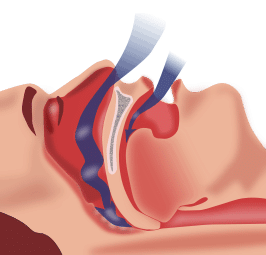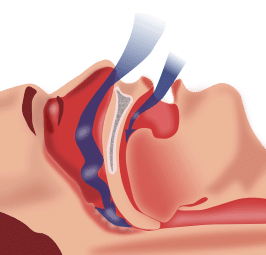
It’s estimated that 22 million Americans have sleep apnea, and that 80 percent of moderate to severe cases are undiagnosed.
Also known as Obstructive Sleep Apnea Syndrome (OSAS), the condition affects between 5 and 20 percent of adults and 10-20 percent of children. While many are familiar with some side effects – loud snoring, disturbed sleep, and daytime sleepiness – other related issues are talked about less, but can be quite severe.
“The disruption of nasal breathing can affect digestion, brain function, mood, attention, growth, heart health, head pain, metabolism and much more,” says Dr. Edmund Lipskis (www.drlipskis.com), director of the Centre For Integrative Orthodontics and co-author with his wife, Dr. Lynn Lipskis, of Breathe, Sleep, Live, Smile: Integrative Treatments for TMJ/TMD, Sleep Apnea, Orthodontics.“But sleep apnea in children can be treated at a young age. The symptoms include irritability, lack of concentration, poor school performance, pseudo ADHD, and nighttime bed wetting.”
Obstructive sleep apnea occurs when a blocked airway prevents the body from getting the oxygen it needs. Breathing can stop for several seconds numerous times during the night.
“This causes the brain to wake up so the sleeper can breathe,” Dr. Lipskis says. “People with OSA usually don’t remember every instance of waking up, but the result is fragmented sleep.”
Dr. Lynn Lipskis adds that proper diagnosis, combined with advanced technology, can lead to successful treatment. She says there are more than 100 FDA-approved appliances for treating sleep apnea and proper selection is key to addressing the individual’s special needs.
“For adults, that can mean therapy using an oral appliance,” she says. “For children, it can mean orthopedic orthodontics for airway development and correction.”
The Lipskis team points out four of the less-discussed but serious side effects of sleep apnea:
Depression. Depression is linked with OSA and works both ways. “That is, people who are depressed are more likely to develop OSA, and people with OSA are more likely to develop depression,” Dr. Lynn Lipskis says. “One study found that slightly less than half of people with OSA showed depressive symptoms. This is not so surprising, considering that restful sleep is so important for physical and mental health.”
Chronic pain. As with depression, chronic pain may be a cause of, or may be caused by, OSA. A study found that over half the people with OSA had chronic widespread pain and that the risk was higher in women than in men.
Hormone disruption. Sleep is a critical time for the body to regulate hormones. “An important one to note is the growth hormone HGH, which is produced during Stage 3 sleep,” Lipskis says. “It helps with cell reproduction, cell regeneration, and metabolism. If Stage III sleep is cut short, or never reached, HGH can’t perform its job. So rather than repairing itself during sleep, the body continues to break down.”
Nocturia. This is the frequent need to urinate at night. “People with OSA are more likely to get up in the middle of the night to go to the bathroom,” Dr. Edmund Lipskis says. “That’s because it affects the release of antidiuretic hormone (ADH), which prevents fluid from filling the bladder and prevents the need to urinate during the night. When ADH can’t do what it’s supposed to, the bladder fills and the urge to urinate appears. This is yet another way that OSA disturbs proper bodily functions and compounds disordered sleep.”
“If you suffer from OSA or suspect you do, have a sleep study done, which includes a diagnosis by a medical physician,” Dr. Lynn Lipskis says. “This is the only way to correctly diagnose OSA or other sleep disorders. OSA should be treated as a serious medical condition because the consequences go far beyond daytime fatigue.”
About Dr. Edmund Lipskis, DDS, MS and Dr. Lynn Lipskis, DDS
Dr. Edmund Lipskis (www.drlipskis.com) is the director of The Centre for Integrative Orthodontics and co-author, with his wife, Dr. Lynn Lipskis, of Breathe, Sleep, Live, Smile: Integrative Treatments for TMJ/TMD, Sleep Apnea, Orthodontics. He is a Master Senior Instructor in the International Board of Orthodontics and board-certified by the International Board of Orthodontics and the American Board of Craniofacial Pain. Co-founder of St. Charles Family Dentistry Ltd. and the TMJ & Sleep Therapy Centre of Chicago, he has lectured internationally on phase-two treatment (via orthodontics) of chronic-pain individuals and airway-focused orthodontics.
Dr. Lynn Lipskis (www.drlipskis.com), a graduate of Loyola University School of Dentistry, is director of the TMJ & Sleep Therapy Centre. She co-founded St. Charles Family Dentistry Ltd. with her husband, with whom she has practiced dentistry for 30 years. She was a clinical instructor in pediatric dentistry at Loyola University School of Dentistry until it closed in 1993. She is a Diplomat of the American Board of Craniofacial Pain and the American Academy of Dental Sleep Medicine. Since 2011, she has concentrated her professional attention on the practice of dental sleep medicine and the treatment of TMJ and chronic pain. The Lipskis’ host a doctors’ course on airway-focused orthodontics on an annual basis.

